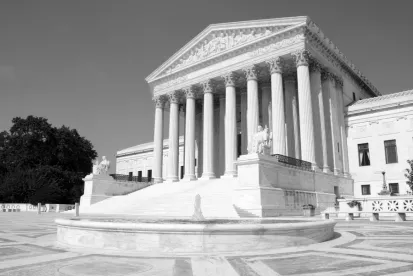On June 21, 2021, in United States v. Arthrex, the United States Supreme Court ruled that Patent Trial & Appeal Board (“PTAB”) Administrative Patent Judges (“APJs”) are unconstitutionally appointed because they effectively wield the power of principal officers while being appointed as inferior officers. 594 U.S. ____ (2021).
The primary question before the Supreme Court was whether APJs, who have the authority to conduct adversarial proceedings and issue decisions regarding the validity of patents, are principal officers or inferior officers. Under the Appointments Clause, U.S. Const. Art. II, § 2, Cl. 2., principal officers must be appointed by the President with the advice and consent of the Senate. Inferior officers may be appointed by the President or by a department head, without Senate approval.
The United States Patent & Trademark Office (“USPTO”) is an executive agency within the Department of Commerce, and the PTAB is therefore an executive adjudicatory body. Only the Director of the USPTO is a principal officer. APJs are inferior officers whom the Secretary of Commerce (a department head) appoints. APJs whose appointments qualify them as inferior officers cannot have the authority of a principal officer without violating the Constitution.
Under the patent statute, Title 35, APJs can adjudicate patent validity. Only APJs can grant rehearing on their decisions regarding patent validity. 35 USC §6(c). As a result, as the statute is written, APJ decisions effectively are not subject to review by the Director of the USPTO.
In October 2019, the Court of Appeals for the Federal Circuit (“CAFC”) held that APJs were unconstitutionally appointed because they were acting as principal officers with too much power independent from the Director of the USPTO. To resolve the issue of unconstitutional appointment, the CAFC deleted part of the pertinent statute (35 USC §3(c)) to take officers of the USPTO out of the provisions of Title 5 and effectively make them at-will employees, thereby reducing the independence of APJs sufficiently to make them inferior officers.
Like the CAFC, the Supreme Court also decided that APJs were functioning as unconstitutionally appointed principal officers rather than properly appointed inferior officers. The Supreme Court held that “the unreviewable executive power exercised by APJs is incompatible with their status as inferior officers.” Ultimately, however, the Supreme Court vacated the CAFC’s decision, finding the CAFC’s remedy of severing the statute to provide at will removal of APJs unsatisfactory. The Supreme Court stated that whether “at-will removal by the Secretary would cure the constitutional problem, review by the Director better reflects the structure of supervision within the PTO and the nature of APJs’ duties.” With respect to the statute itself, the Supreme Court identified 35 U. S. C. §6(c) as “unenforceable as applied to the Director insofar as it prevents the Director from reviewing the decisions of the PTAB on his own.” The Supreme Court stated that in order for this provision to be constitutional, “[t]he Director may engage in such review and reach his own decision.”
The Supreme Court concluded that “the exercise of executive power by inferior officers must at some level be subject to the direction and supervision of an officer nominated by the President and confirmed by the Senate.” The Supreme Court held that the Director need not review every decision of the PTAB. “What matters is that the Director have the discretion to review decisions rendered by APJs. In this way, the President remains responsible for the exercise of executive power—and through him, the exercise of executive power remains accountable to the people.”
The Supreme Court effectively acknowledged the impractical reality that the Director cannot personally review the hundreds of decisions that the PTAB issues each year, to decide which decisions to rehear. Apparently, it will be left to the Director to decide how that will be done. For now, there is no mechanism in place for patent owners or patent challengers to request that the Director review a final PTAB decision.
Takeaway
The Supreme Court decision appears to be part of an effort to maintain status quo at the PTAB. As a practical matter, with the recent change in presidential administration, the current USPTO Director is an Acting Director from within the USPTO, not appointed by the President with the advice and consent of the Senate. The constitutional infirmity that both the CAFC and the Supreme Court identified will continue until the President appoints a Director, and the Senate confirms the appointment. An inferior officer of the USPTO will hold the power to review the decisions of other inferior officers.





 />i
/>i

